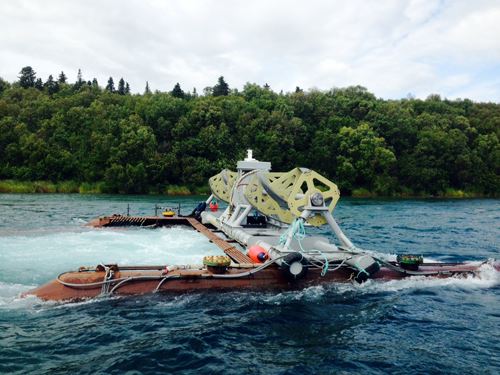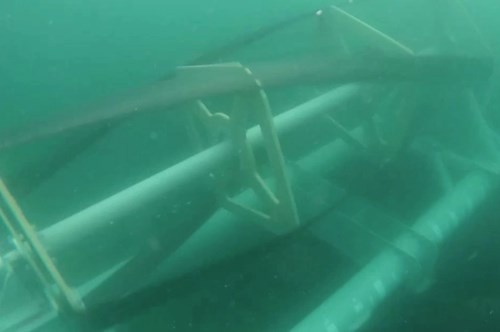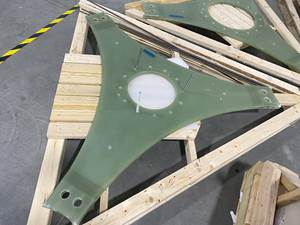ORPC successfully tests river power generation system in Alaska
RivGen Power System powered a micro-grid in a small Alaskan town, and shows potential for remote power supply.
Ocean Renewable Power Company (ORPC, Portland, Maine) is pleased to announce it has concluded its highly-successful, trademarked RivGen Power System demonstration project in the Kvichak River at the remote river village of Igiugig, Alaska, 275 miles southwest of Anchorage. ORPC's RivGen Power System is a 25-kilowatt system designed to reduce and stabilize the cost of power in remote communities located near rivers and tidal estuaries that currently use diesel fuel for power generation.
"We are thrilled with the successful demonstration of the self-deployment and power generation features of our system and the lessons learned will be invaluable to us as we complete our commercial design of RivGen next year," said ORPC president and CEO Chris Sauer. He adds, "We are indebted to our Alaska-based project team, the Village of Igiugig, and the local contractors whose professionalism, ingenuity and perseverance really paid off."
"With incredible teamwork and ingenuity, ORPC and Igiugig Village generated hydrokinetic power from the Kvichak River!" says AlexAnna Salmon, Igiugig Village president. "The Council is impressed that the RivGen system was installed with local equipment, provided significant power for our micro-grid, and most importantly, coexisted with the fish habitat that the Kvichak River is so famous for. We are very thankful to everyone that has made this journey a success."
Other project highlights include: several successful deployments and retrievals using only the device's ballasting system, thereby proving the self-deploying/retrieval features of the system; remote operation and adjustment of the system via network by ORPC engineers; delivery of the projected amount of power to the on-shore station; and comprehensive environmental monitoring of the device that showed that the operating power system had no known negative impacts on fish and other aquatic life.
ORPC hosted tours to the project site for a dozen or more state officials and representatives of Alaska Native Corporations and other business interests during the week of August 25. Guests toured Igiugig, viewed the RivGen system in operation by boat, learned about the project's environmental monitoring protocols, and met with Dr. Brian Polagye of the University of Washington, who was on-site as part of a U.S. Dept. of Energy-funded project to develop advanced control systems for marine hydrokinetic devices to improve performance of such devices in turbulent current conditions.
The cost of electricity in Igiugig is nearly $0.80/kWh (versus a national average of $0.10/kWh) due to its reliance on diesel generation. This project was a crucial step forward in reducing the cost and environmental impacts from electricity generation in Igiugig and rural river communities around the globe. The RivGen Power System Commercialization Project was partially funded by the Denali Commission and Alaska Energy Authority.
ORPC made history by delivering power to the New England grid from the company's TidGen Power System installed in Cobscook Bay, Maine. The Cobscook Bay project was the first commercial, grid-connected hydrokinetic tidal energy project to deliver power to a utility grid in North, Central or South America. With this unique experience, ORPC now offers strategic expertise and support to other river and ocean energy projects through its subsidiary, ORPC Solutions.
In Alaska, the company has invested over $2.6 million since 2009 and has built a supply chain of over 50 partners and contractors throughout the state, including the University of Alaska at Fairbanks and Anchorage. Since 2007, ORPC has invested more than $25 million into the Maine economy and created or retained more than 100 jobs statewide. ORPC's hub at Eastport and Lubec, Maine, has become an internationally recognized center for river and tidal energy development.
Related Content
Recycling end-of-life composite parts: New methods, markets
From infrastructure solutions to consumer products, Polish recycler Anmet and Netherlands-based researchers are developing new methods for repurposing wind turbine blades and other composite parts.
Read MoreRTM, dry braided fabric enable faster, cost-effective manufacture for hydrokinetic turbine components
Switching from prepreg to RTM led to significant time and cost savings for the manufacture of fiberglass struts and complex carbon fiber composite foils that power ORPC’s RivGen systems.
Read MoreHexagon Purus opens new U.S. facility to manufacture composite hydrogen tanks
CW attends the opening of Westminster, Maryland, site and shares the company’s history, vision and leading role in H2 storage systems.
Read MoreInfinite Composites: Type V tanks for space, hydrogen, automotive and more
After a decade of proving its linerless, weight-saving composite tanks with NASA and more than 30 aerospace companies, this CryoSphere pioneer is scaling for growth in commercial space and sustainable transportation on Earth.
Read MoreRead Next
“Structured air” TPS safeguards composite structures
Powered by an 85% air/15% pure polyimide aerogel, Blueshift’s novel material system protects structures during transient thermal events from -200°C to beyond 2400°C for rockets, battery boxes and more.
Read MoreDeveloping bonded composite repair for ships, offshore units
Bureau Veritas and industry partners issue guidelines and pave the way for certification via StrengthBond Offshore project.
Read MoreAll-recycled, needle-punched nonwoven CFRP slashes carbon footprint of Formula 2 seat
Dallara and Tenowo collaborate to produce a race-ready Formula 2 seat using recycled carbon fiber, reducing CO2 emissions by 97.5% compared to virgin materials.
Read More
















.jpg;maxWidth=300;quality=90)









